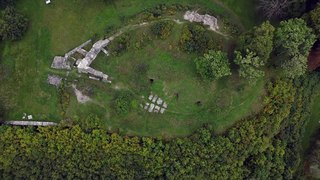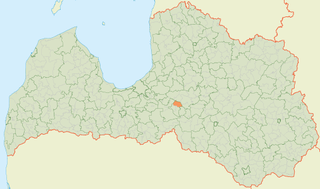
Cēsis, is a town in Latvia located in the northern part of the Central Vidzeme Upland. Cēsis is on the Gauja River valley, and is built on a series of ridges above the river overlooking the woods below. Cēsis was one of the candidate cities for the title of European Capital of Culture 2014.

Tukums is a town in the Courland region of Latvia. Three regions of Latvia meet in the vicinity of Tukums – Vidzeme, Zemgale and Courland.

Koknese is a historic town in Aizkraukle Municipality in the Vidzeme region of Latvia, on the right bank of the Daugava River. It has a population of nearly 3,000.

Lihula is a town in Lääneranna Parish, Pärnu County, Estonia.

Ikšķile is a town in Latvia, in Ogre Municipality. It was the first capital of the Roman Catholic Bishopric of Livonia, known by the German name of Üxküll. Saint Meinhard, known from the Livonian Chronicle of Henry, was the first bishop of Üxküll. In 1197 Berthold of Hanover, a Cistercian abbot of Loccum, was made the second bishop of Üxküll. Those days the town was the center of the upcoming crusading activities in the Livonian area. Bishop Berthold moved the episcopal see to Riga, but was killed by the Livs in battle.

Ulla Salzgeber is a German equestrian and Olympic champion who competes in the sport of dressage. Competing in the 2000 and 2004 Summer Olympics, she won two team gold medals, one individual silver and one individual bronze. She also won numerous medals at the World Equestrian Games, Dressage World Cup and European Dressage Championships. After the retirement of her Olympic horse, Rusty, after the 2004 Games, and unexpected death of her second international-level mount in 2005, Salzgeber struggled to find a new Grand Prix-level horse.

The Krimulda Castle is located just outside Sigulda, Sigulda Municipality in the Vidzeme region of Latvia and is a tourist attraction. The castle dates from the 14th century and was destroyed in a war in 1601. Prince Liven’s living house was built in the classic style. The manor complex consists of steward’s house, coach house, Swiss cottage, etc. Home wine tasting is available by prior arrangement.

The ruins of Embūte Castle are located in Embūte, Latvia, in Embūte Parish, Vaiņode Municipality, not far from an ancient hillfort erected by Curonians. It was an ancient Curonian settlement and is mentioned in ancient chronicles as a place with strong Curonian resistance to German crusaders. The bishop's castle was built as a border castle with Lithuania by Livonian Order on a steep hill on the right bank of the Lanka river, which flows into left tributary of the Venta. Later manor house was built using the walls of the former castle, which can be seen in the division of the rooms and the building material. Today, the ruins are surrounded by trees and are in poor condition.

Lēdmane Parish is an administrative unit of Ogre Municipality in the Vidzeme region of Latvia.

Kurmāle Parish is an administrative unit of Kuldīga Municipality in the Courland region of Latvia. The parish has a population of 2209 and covers an area of 113.68 km2.

Alsunga Castle is a castle in Alsunga village, in Alsunga Parish, Kuldīga Municipality in the Courland region of Latvia. It was built for the Livonian Order during the first half of the 14th century.

Jaunauce Manor is a manor house in Jaunauce parish in Saldus municipality in the historical region of Courland, in western Latvia.

Reņģe Manor, also called Ruba Manor, is a manor house for the von Nolcken family that was built between 1881 and 1882 in the historical region of Zemgale, in Latvia. It is located about 2.5 km west of both the village of Ruba and the railroad bridge where the Glūda–Reņģe Railway crosses the Vadakste river along the border of Latvia and Lithuania. Manor building currently houses the Ruba Elementary School.

Burtnieki Castle is a castle in Burtnieki Parish, Valmiera Municipality in the Vidzeme region of Latvia. It was built on the south shore of Lake Burtnieks for the Livonian Order around 1284.

Dzērbene Manor is a manor house in the historical region of Vidzeme, northern Latvia.

Gaujiena Castle is a castle in the historical region of Vidzeme, in northern Latvia. It was built between 1236 and 1238. Severely damaged in 1702 during the Great Northern War, the structure was abandoned.

Mālpils Manor is a manor house in the historical region of Vidzeme, in northern Latvia.

Lielvārde Castle is a castle in Lielvārde - town in the historical region of Vidzeme, in northern Latvia. Castle has been built at the steep bank of Daugava River, overseeing this important medieval waterway. Built before 1248 by Albert of Buxthoeven, an archbishop of Riga. During the Livonian War, Lielvārde Castle was destroyed by Russian troops in 1579. Conserved ruins up to the level of second floor.

Ludza Castle was a medieval castle built in Gothic style located next to a Catholic church, on the site of a former Latgalian wooden castle in the centre Ludza, Latvia, a small town in eastern Latgale. Its main purpose was to be an eastern outpost to control trade routes from Russia. Nowadays the impressive fragments of the castle walls, including a three-floor high fragment, still remain. The ruins are the main tourist attraction in the Ludza District, and is considered a symbol of the town.

Vooru is a village in Viljandi Parish, Viljandi County, Estonia. It is 34 km southeast of the town of Viljandi, 2 km south of the village of Suislepa, near the southern border of Valga County and the Õhne river. As of 2011, the population of Vooru was 65, a decrease from 101 in the 2000 census.




















